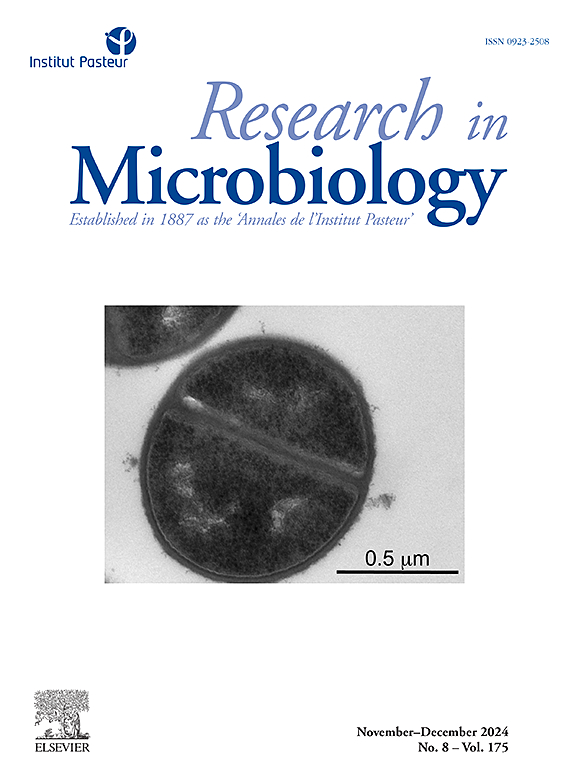Metabolic complexities and heterogeneity in quorum sensing signaling molecules in bacteria isolated from black band disease in a Caribbean coral
IF 3.4
4区 生物学
Q3 MICROBIOLOGY
引用次数: 0
Abstract
Coral diseases contribute to the worldwide loss of coral reefs, with the Black Band Disease (BBD) being a prominent example. BBD is an infectious condition with lesions with a pigmented mat composed of cyanobacteria, sulphate-reducing, sulphide-oxidizing, and heterotrophic bacteria. We compared the heterotrophic bacterial communities of healthy and BBD-affected colonies of the Caribbean coral Orbicella faveolata using culture-dependent and -independent techniques. Twenty and 23 bacterial isolates were identified from healthy and diseased tissues, respectively, which differed in their capacities to metabolize carbohydrates and citrate, either anaerobically or aerobically. They also differed in their quorum-sensing (QS) activity, as QS signaling molecules were found exclusively, and QS-inhibition was found primarily, in isolates from diseased tissues. Screening of bacterial diversity by 16SrDNA metabarcoding showed that members of the bacterial genera Muricauda and Maritimimonas were dominant in healthy tissues whereas members of the cyanobacterial genus Roseofilum were dominant in diseased tissues. These results suggest that bacterial dysbiosis can be linked with altered bacterial communication, likely leading to diachrony and imbalance that may participate in the progression of BBD. Investigating physiological traits and QS-based communication offers insights into the onset and progression of coral infections, paving the way for novel strategies to mitigate their impact.
从加勒比珊瑚黑带病中分离出的细菌的代谢复杂性和法定量感应信号分子的异质性。
珊瑚疾病是造成全球珊瑚礁消失的原因之一,黑带病(BBD)就是一个突出的例子。黑带病是一种由蓝藻、硫酸盐还原菌、硫氧化菌和异养菌组成的色素垫层病变的传染性疾病。我们使用独立和非独立培养技术,比较了加勒比海珊瑚 Orbicella faveolata 健康珊瑚群和受 BBD 影响珊瑚群的异养细菌群落。分别从健康组织和患病组织中鉴定出了 20 和 23 个细菌分离物,它们在厌氧或需氧条件下代谢碳水化合物和柠檬酸盐的能力各不相同。它们在法定人数感应(QS)活性方面也存在差异,因为在病变组织的分离物中只发现了 QS 信号分子,而在病变组织的分离物中主要发现了 QS 抑制因子。通过 16SrDNA 代谢编码筛选细菌多样性的结果表明,健康组织中主要是 Muricauda 和 Maritimimonas 细菌属的成员,而病变组织中主要是 Roseofilum 蓝藻属的成员。这些结果表明,细菌失调与细菌交流的改变有关,很可能导致异步和失衡,从而参与 BBD 的发展。通过研究生理特征和基于 QS 的交流,可以深入了解珊瑚感染的发生和发展过程,为制定减轻其影响的新策略铺平道路。
本文章由计算机程序翻译,如有差异,请以英文原文为准。
求助全文
约1分钟内获得全文
求助全文
来源期刊

Research in microbiology
生物-微生物学
CiteScore
4.10
自引率
3.80%
发文量
54
审稿时长
16 days
期刊介绍:
Research in Microbiology is the direct descendant of the original Pasteur periodical entitled Annales de l''Institut Pasteur, created in 1887 by Emile Duclaux under the patronage of Louis Pasteur. The Editorial Committee included Chamberland, Grancher, Nocard, Roux and Straus, and the first issue began with Louis Pasteur''s "Lettre sur la Rage" which clearly defines the spirit of the journal:"You have informed me, my dear Duclaux, that you intend to start a monthly collection of articles entitled "Annales de l''Institut Pasteur". You will be rendering a service that will be appreciated by the ever increasing number of young scientists who are attracted to microbiological studies. In your Annales, our laboratory research will of course occupy a central position, but the work from outside groups that you intend to publish will be a source of competitive stimulation for all of us."That first volume included 53 articles as well as critical reviews and book reviews. From that time on, the Annales appeared regularly every month, without interruption, even during the two world wars. Although the journal has undergone many changes over the past 100 years (in the title, the format, the language) reflecting the evolution in scientific publishing, it has consistently maintained the Pasteur tradition by publishing original reports on all aspects of microbiology.
 求助内容:
求助内容: 应助结果提醒方式:
应助结果提醒方式:


